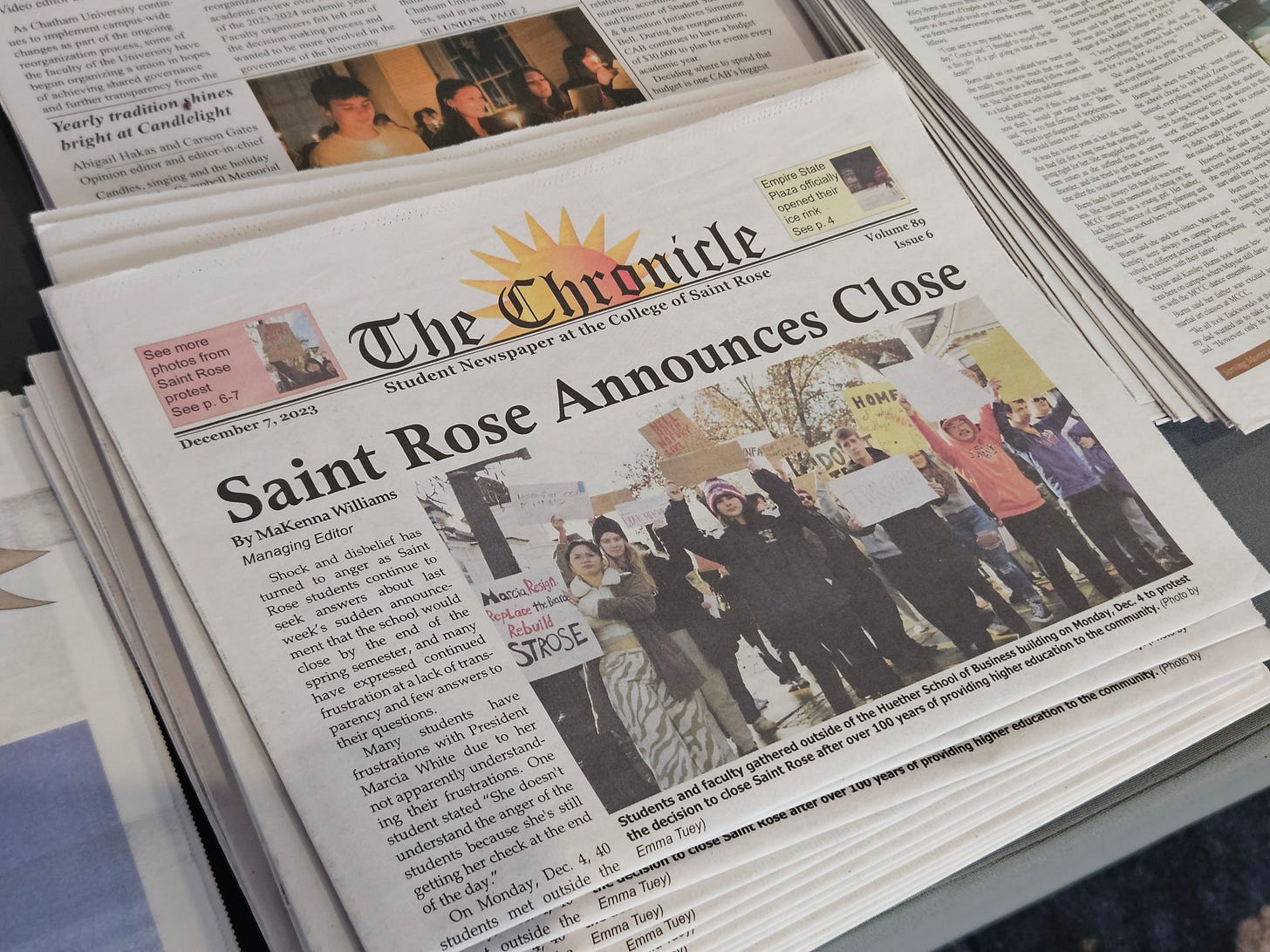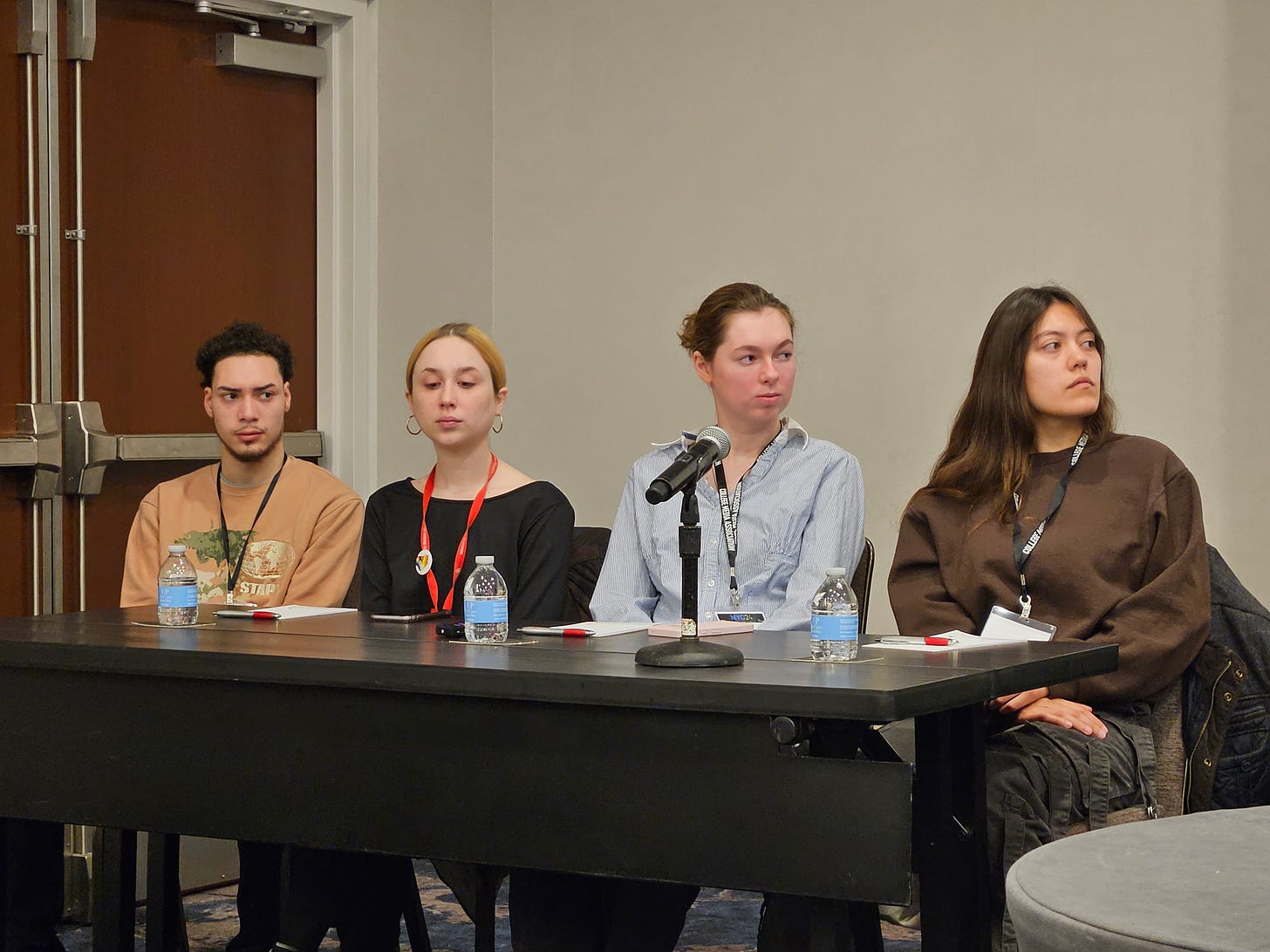Inside upstate New York student paper’s coverage of its college closing
Their takeaway: Don’t believe admin’s 'everything-is-fine' narrative

Despite several warning signs, administrators at a New York private college kept telling its student journalists everything was fine.
Until it wasn’t.
The closure of the College of Saint Rose in Albany after 103 years of operation has underscored the challenges faced by student journalists at the campus newspaper, The Saint Rose Chronicle.
They reflected on their ongoing closure coverage at the College Media Association convention in New York City last month. One of the main challenges, they said, was the college’s lack of transparency.
The student journalists and the community didn’t even learn about the closure from the college’s official channels. They knew from a local news report.
Editor-in-Chief Abby Bravo said she was contacted by a journalist seeking comments about a Saint Rose story they were working on. She thought it was just going to be another story of the college’s financial troubles.
“A couple hours later, I got an email from this journalist with the headline ‘Saint Rose closure,’” Bravo said. “I hadn’t heard anything about any talks of closing.”
Bravo didn’t respond to the email as she was still trying to figure out what happened with her peers. Less than half an hour later, Channel 13 News broke the closure story, citing Board of Trustees’ votes.
Initially, The Chronicle was going to run its next issue’s front page about the holiday season. Not anymore.
“It looks like we have a new front page story guys, no more Christmas tree lighting,” advisor Shawn McIntosh said of a Slack message he sent to the newsroom after the news broke.
The closure didn’t come as a surprise.
There were warning signs the newspaper kept track of including multiple program cuts, layoffs, building sales, usage of facilities as debt collateral, declining enrollment and withdrawal from bond ratings.
A few months before the closure announcement in November, the college learned its accreditation was in jeopardy, in part because of concerns about its financial planning and budget process.
Bravo said she asked the provost about it but didn’t get any usable response.
“She was very cold, she shut me down pretty fast,” Bravo said. “Again, (the provost told her) everything’s fine like you don’t know what you’re talking about.”
As a journalism student, Bravo said she knew she had to keep coming back because “everything’s fine” had never been true.
The administration didn’t respond to The Nutgraf’s request for comments about The Chronicle’s challenges and its closure coverage.
The college also pulled itself out of Fitch Ratings, a bond rating agency.
For those who don’t know: Bond ratings are essentially credit scores for institutions. Not having a bond rating means it’s unlikely the school could secure financing.
The Chronicle tried to get a story on that but was shut down by sources who didn’t want to go on the record — a problem Managing Editor Savannah Torebka said often persists when covering the closure.
Torebka said she was looking for an expert to explain what a bond rating system is in layman's terms so that students would understand.
“I knew they didn’t want to speak on the record and potentially get themselves in trouble by saying their opinions on it,” she said. “But they would, at least initially, they were willing to at least share information from a business perspective.”
But that also didn’t happen. The story wasn’t told until it was picked up by a local outlet first, Torebka said.

Recalling when they were reading the stories from local media, McIntosh said it was a “teachable” moment to go through them line by line with students.
He said they looked at the message the university’s “one-line statements” sent, how each quote was arranged and how different framings can give points of view while doing an objective news story.
“We could either look at this as a really bad, horrible time for us,” he said. Or “We got nothing left to lose, let’s just go for it and let’s take it to learn as much as possible with this process. … It’s a good experience for student journalists, it’s unfortunate they’re living through it.”
If there was one thing students learned, Torebka said it would be to not give in even in the face of roadblocks from sources.
Many of the stories she wrote happened after she was shut down several times, she said.
“I’ve found that if you keep bothering them enough in a respectful way,” Torebka said, “if you keep annoying them, they will cave at some point.”
The Chronicle staffers said while following up on the closure is a priority, it’s still important to cover other aspects of campus life.
Since the closure, they have written stories about teach-out plans, effects on the local community and reactions from businesses, among others.
“Even in these times that things are so stressful … you have to try and just seize this opportunity,” Torebka said. “This is the best journalistic experience that I’ve ever had.”
Zooming out
In 2023, 15 four-year colleges and universities announced closures. These included The King’s College in New York, Lincoln Christian University in Illinois and Alderson Broaddus University in West Virginia.
Some other institutions didn’t close but announced mergers or acquisitions.
These closures were attributed to a dip in enrollment accelerated after the COVID-19 pandemic, Inside Higher Ed reported.
Here are some warning signs St. Rose saw before the closure announcement. If any of these happens at your institution, start asking questions:
Struggles to maintain the number of students enrolled at the college
Usage of buildings as debt collateral
Sales of eight college-owned properties, a deal that wasn’t made public
Construction of new facilities other than dorms, which would create revenue
Layoffs and cuts of programs that new facilities aimed to serve
Continued deficit growth despite cuts that aimed to address those shortfalls
More property purchases despite operating at a loss
Talks of mergers and possible acquisitions
Story Spotlight:
Information institutions can’t hide (Inside Higher Ed): Where to track down financial statements, tax forms and other key information that nonprofit colleges and universities don’t necessarily make it easy for you to find. 🔎 TL;DR? These records that should be available at private institutions include audited financial statements, U.S. Internal Revenue Service form 990, credit ratings and statistics from the U.S. Department of Education.
Featured Opportunities:
Poynter is hosting a webinar on the state of fact-checkers on April 2.
A free webinar April 8 discusses covering 2024 elections: “Not the odds, but the stakes”
The 25th International Symposium on Online Journalism will be online and in person at the University of Texas at Austin April 12-13. Register for virtual participation for $30.
STAT News in Boston is looking for a Sharon Begley science reporting fellow. Apply before April 26.
WETA and PBS NewsHour have several summer internship openings.
D.C. residents over 18 years old can apply to this free, 12-week community journalism training program.
Nominations for the SPLC’s Student FOI Award are open now with a deadline of May 31.
Univision is looking for a full-time news production intern for the summer.






